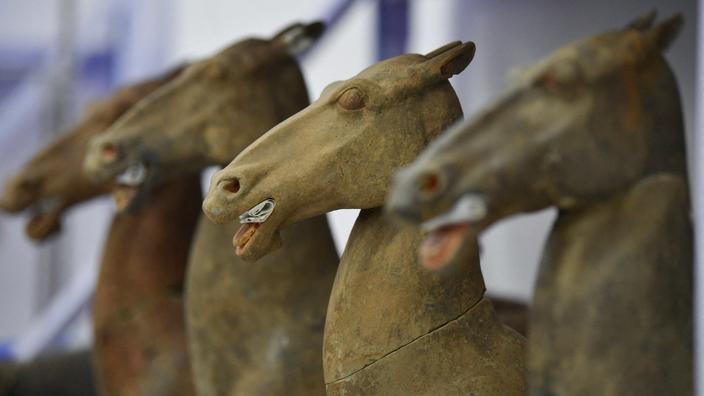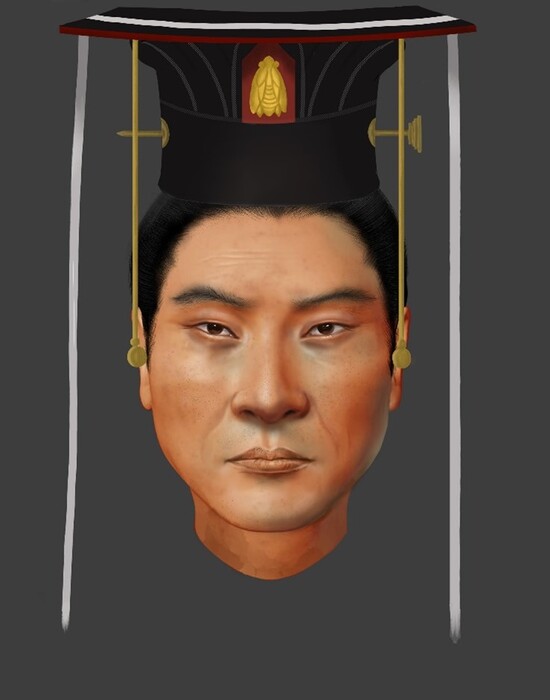The emperor did not rest in the solid flanks of the mountains bordering Xi'an, in central China, but on the edge of the ancient capital of the Middle Empire for thousands of years.
Han Wendi, also known by his birth name - Liu Heng - was the fifth ruler of the Han Dynasty (206 BC - 220 AD).
“Good emperor”, according to Chinese historiography, he was considered to be a model of temperance, even asceticism.
A trait which had led him, at the end of twenty years of a prosperous reign (180-157 BC), not to be buried with his ancestors, but elsewhere.
In the distance.
And to the chagrin of Chinese archaeologists who have long sought his grave.
Read also Gold masks, lost cities, protohistoric map ... The most remarkable discoveries of 2021
More than two millennia after his death, the search for the tomb of Liu Heng would have finally succeeded, however announced in December the National Administration of Cultural Heritage in China (NCHA), at a press conference.
The emperor's mausoleum would ultimately be on the grounds of Jiangcun village, not far from the former capital of Chang'an (present-day Xi'an, in Shaanxi province).
The site, in the process of being excavated since 2017, recently delivered decisive remains to researchers from the Shaanxi Academy of Archeology in charge of the excavation.
Namely, seals engraved with the name of Emperor Wendi.
Which confirm what already strongly predicted the immediate vicinity, respectively 800 and 2000 meters, the mausoleums of his wife and his mother.
The room cannot be found
"After having crossed our data with the available historical sources, we can conclude that the funeral complex of Jiangcun is indeed the mausoleum of the emperor Wendi"
Archaeologist Ma Yongying, responsible for excavating the site for the Archaeological Academy of Shaanxi Province, said last month.
Recorded by the Chinese authorities in the 1960s, the site has not been equated with the lost tomb of Emperor Wendi for a very simple reason: his burial has long - and traditionally - been identified not far from there.
Two kilometers to the north, precisely, on the site of Fenghuangzui, where centuries-old inscriptions located the tomb of Emperor Han Wendi.
Equipped with a monument under the Qing dynasty, this historic site was however viewed with suspicion by archaeologists who never found the slightest trace of a tomb.
The mausoleum of an ancient emperor found near Xi'an (China)
Go to the slideshow (9)
The complex that was in Jiangcun's bowels suffered from another flaw. And not the least: it did not have a tumulus, the monumental earthen rise which historically marks the tomb of the emperors of China. Why did you ignore the
ya
, this earth pyramid that turns every imperial tomb into a sacred hill, like the tomb of Liu Heng's mother, Empress Dowager Bo? By modesty, suggest the Chinese archaeologists, in reference to the proverbial humility of the emperor. This would not be the only example. Around Chang'an, Jiangcun is located opposite the site of Xianyang, where the mausoleums of the first emperors of the Han dynasty (nicknamed the Western Han) are still displayed today,like Han Gaozu and Han Huidi. Astonishing isolation.
Read alsoBetween London and Athens, the eternal quarrel over the Parthenon
In the depths of the ground, Chinese scientists have yet found familiar structures.
Four underground access ramps would lead to the entrance to the funeral complex arranged some 2 to 4 meters underground, for a general size of the site estimated at nearly half a hectare.
As for its deepest foundations, they would go down to 30 meters, according to figures cited by the Chinese state news agency Xinhua.
"Its plan and dimensions correspond to the graves of the greatest dignitaries of the Western Han Dynasty
," archaeologist Ma Yongying pointed out.
These observations are corroborated by our excavation of the exterior burial pits that surround the tomb ”.
Figurines, ornaments and gears
Indeed, more than 110 burial pits have been identified on the site, around the imperial mausoleum itself. Of the eight pits fully excavated, Chinese archaeologists have unearthed more than 1,500 remains of ceramics, gold and silver adornments, a few weapons such as crossbows, as well as various iron and bronze objects, including seals. , elements of harness, wheelwright as well as copper gears. More than 1000 terracotta figures have been counted, including horses and various polychrome courtiers, supposed to accompany the deceased into the beyond. Nothing quite as exceptional in quality as the 8,000 clay soldiers at the nearby mausoleum of Qin Shi Huangdi, admittedly, but a related invoice, Han Wendi having died less than a century after theunifier of classical China.
Read alsoHow Xi Jinping, emperor and dictator, locks down China
While the heart of this vast funeral complex is still waiting to be excavated, researchers at the Academy of Archeology of Shaanxi Province are already delighted by the contribution of the first discoveries made in Jiangcun. Thus, the separate burial of the emperor and his wife would constitute a break with the practice of Han Wendi's immediate predecessors.
"Liu Heng's tomb testifies that the state, represented in his time by the power of the emperor, had priority"
over the royal couple, offers to interpret Ma Yongying, quoted by the pro-government Chinese daily
China Daily
. Some of the seals discovered were also attributed to departments of the Imperial Court.
"This shows that these pits reproduced in a funeral context the entire system of government"
, also assures the archaeologist.
Finally, the discovery of the tomb of Emperor Han Wendi completes the identification of the imperial burials of all the Western Han, who reigned in Chang'an until the year 9 of our era.
"This discovery fills the last missing link that remained to us about the evolution of the imperial tombs of the Western Han dynasty"
, rejoiced in December for the pro-Chinese daily newspaper
Global Times
, archaeologist Cao Long, who took part in the work.
The various excavation campaigns should continue around the Han complex in Jiangcun and confirm the announcement by the Chinese archaeological authorities.
This large-scale excavation operation is also a very educational campaign for the archaeological teams in the region, who are still waiting to begin, one day perhaps, the excavation of the gigantic mausoleum of Qin Shi Huangdi.
A site that has been preserved for about fifty years for future generations.





